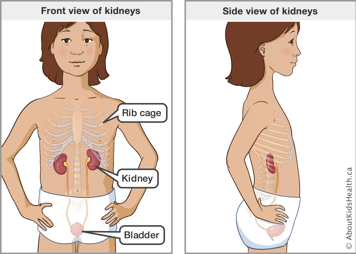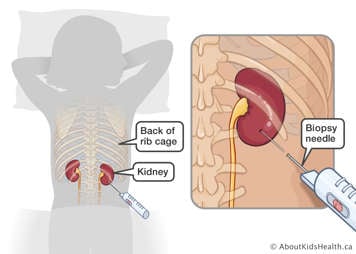What are the kidneys?
The kidneys filter waste products from the blood and create urine. They are a pair of organs that are usually located in your child's back, one on each side of the spine, near the bottom of the rib cage.

What is a kidney biopsy?
A kidney biopsy is a procedure where a doctor takes a tiny piece of kidney tissue using a special needle. The tissue is examined under a microscope in the laboratory. The biopsy is done using image guidance by an interventional radiologist.
Why is a kidney biopsy done?
A kidney biopsy can help your child’s health-care team determine the cause of your child’s illness. It can also help the health-care team learn about how your child’s illness is changing.
Risks of a kidney biopsy
Kidney biopsies are usually low-risk procedures. The risk may increase depending on your child’s condition, age and health.
The risks of a kidney biopsy can include:
- blood in the urine
- bleeding around or into the kidney
- infection
- needle injury to any other nearby organ
- urine leak from the kidney
- kidney damage
- biopsy does not provide a diagnosis
Visiting the clinic before the procedure
Your child may have a clinic visit with the interventional radiologist before the procedure. During the visit you should expect:
- A health assessment to make sure your child is healthy and that it is safe to have local anaesthesia, sedation or general anaesthesia and to go ahead with the procedure.
- An overview of the procedure, and a review of the consent form with an interventional radiologist.
- A quick ultrasound of the kidneys; the area where the biopsy will be taken will be marked with a semi-permanent marker.
- Blood work.
Giving consent before the procedure
Before the procedure, the interventional radiologist will go over how and why the procedure is done, as well as the potential benefits and risks. They will also discuss what will be done to reduce these risks and will help you weigh any benefits against the risks. It is important that you understand all the potential risks and benefits of the kidney biopsy and that all your questions are answered. If you agree to the procedure, you can give consent for treatment by signing the consent form. A parent or legal guardian must sign the consent form for young children. The procedure will not be done unless you give your consent.
How to prepare your child for the procedure
Before any treatment, it is important to talk to your child about what will happen. When talking to your child, use words they can understand. Let your child know that medicines will be given to make them feel comfortable during the procedure.
Children feel less anxious and scared when they know what to expect. Children also feel less worried when they see their parents are calm and supportive.
If your child becomes ill within two days before the procedure
It is important that your child is healthy on the day of the procedure. If your child starts to feel unwell or has a fever within two days before the kidney biopsy, let the health-care provider who ordered the biopsy know. Your child’s procedure may need to be rebooked.
Food, drink and medicines before the procedure
- Your child’s stomach must be empty before sedation or general anaesthetic.
- If your child has special needs during fasting, talk to your child's health-care team to make a plan.
- Your child can take their regular morning medicine with a sip of water two hours before the procedure.
- Medicines such as acetylsalicylic acid (ASA), naproxen or ibuprofen, warfarin or enoxaparin may increase the risk of bleeding. Do not give these to your child before the procedure unless they have been cleared first by their health-care provider and the interventional radiologist.
On the day of the kidney biopsy
Arrive at the hospital two hours before the planned time of your child’s procedure. Once you are checked in, your child will be dressed in a hospital gown, weighed, and assessed by a nurse. You will also be able to speak to the interventional radiologist who will be doing the kidney biopsy and the nurse or anaesthetist who will be giving your child medication to make them comfortable for the procedure.
During the kidney biopsy you will be asked to wait in the surgical waiting area.
Your child will have medicine for pain
It is important that your child is as comfortable as possible for the procedure. They may be given local anaesthesia, sedation or general anaesthesia. The type of medicine that your child will have for the procedure will depend on your child’s condition.
How a kidney biopsy is done
Your child’s kidneys are located in their back area, usually one on either side. For the biopsy, your child will be lying on their stomach. The interventional radiologist uses ultrasound to view the kidneys. Local anaesthetic is then injected into the skin to numb the biopsy area. Then, while watching the kidney using the ultrasound, the interventional radiologist passes a special thin needle into one of the kidneys to get samples. Usually, two or three samples are taken.

The samples are about 2 to 3 centimeters (1 inch) long and look like a piece of thread. These kidney samples are then sent to the lab for examination.
You child will usually not need any stitches. A small bandage is placed over the biopsy site.
A kidney biopsy usually takes 45 minutes to one hour.
If your child has had a kidney transplant
If your child has had a kidney transplant, they will lie on their back for the biopsy because the transplanted kidney is located closer to the front of the abdomen. The biopsy procedure is the same as described above.
A kidney biopsy from a transplanted kidney will usually take 45 minutes to one hour.
After the kidney biopsy
Once the kidney biopsy is complete, your child will be moved to the recovery area. The interventional radiologist will come and talk to you about the details of the procedure. As soon as your child starts to wake up, a nurse will come and get you.
Recovery in hospital
Your child will need to lie in bed for approximately eight hours after the biopsy. There will be a sandbag placed under your child’s back to apply pressure to the biopsy site. This helps to prevent the site from bleeding. If your child has had a kidney transplant, the sandbag will be placed on your child’s abdomen.
If there is no blood in the urine and no bleeding from the biopsy site after two hours, the head of your child’s bed may be raised slightly.
Going home
Most children who have a kidney biopsy go home the same day. This is usually eight hours after the biopsy.
Your child will be observed closely for these eight hours before being discharged home. Your child will have a blood test about six hours after the biopsy to identify any changes in blood levels. If there are any concerns that there may be bleeding, an ultrasound may be ordered. Your child may have to stay on bed rest or be admitted overnight for further observation if the health-care team feels it is necessary.
If you live more than one hour away from the hospital, you will need to stay nearby overnight.
For more details on how to care for your child after a kidney biopsy and if/when to seek medical attention, please see: Kidney biopsy: Caring for your child at home after the procedure.
Results
Your child’s health-care provider will receive the results of your child’s kidney biopsy. You will need to make an appointment with them to discuss the results.
If you have any concerns in the first 48 hours, call the Image Guided Therapy (IGT) clinic at (416) 813-7654 ext. 201804. Speak to the IGT clinic nurse during working hours or leave a non-urgent message.
If you have concerns and it is after working hours, see your child’s health-care provider or go to the nearest Emergency Department. You can also call the Hospital for Sick Children switchboard at (416) 813-7500 and ask them to page a member of your child’s health-care team or the interventional radiology fellow on call.
For more information on fasting see Eating and drinking before surgery.
For more information on preparing your child for their procedure see Coming for surgery.